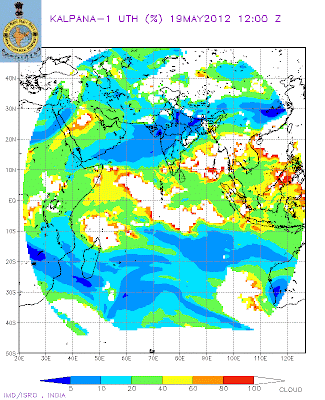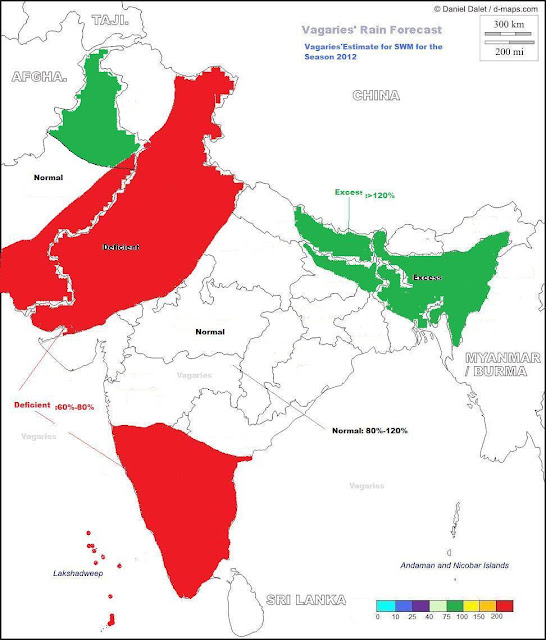Mumbai Lake Position Put up on Mumbai Page..
This IMD Image, super imposed with "A" and "B" by Vagaries, shows 2 distinct developments !I project this satellite image with winds movement to make things easier to explain.
On the left (A) is the developing low, as indicated by the wind directions around it. Getting ready in the next 24 hrs.
On the right (B) is the Monsoon cloud. The SW winds near the coast between the clouds and the mainland is fairly convincing indicating the SWM to move into Kerala in the next 48 hrs.
More Later..
B1 now seen as a low 1t 996 mb, merged with the trough. Moved N/NE as expected and at 20.4N and 92.6E today (Friday). Rains expected in coastal regions to be heavy.
It's Reached 50c !
Larkana and Mohenjo Daro touched 50c today (Thursday, 31st May). Vagaries had been predicting and anticipating this since the last 2 days.
Sukkur soared to 49c, and Dadu and Sargodha were 48c. Sukkur saw a low of 31c.
Yesterday vagaries had estimated a rise in the region for Thursday.
In India, Churu was hottest at 48.7c, Allahbad was 47.8c. Amritsar was just short of its all time record by 0.2c. It was 47.6c on Thursday. Brahmapuri was also at 47.6c, Agra at 47.1c, Gwalior 47.0c, Chandrapur saw 47.0c.
Delhi Palam baked at 47.0c, and S'Jung was sizzling at 45.4c.
Kota bottomed a low of 33.8c and Nagpur 33.7c on Thursday morning.
Orissa was spared the extreme heat for the second day today. At least it was not as hot as it was before last Tuesday. Highest was 45.5c at Bolangir followed by 45c at Sundargarh.
B-1 has moved N and was centered at 18.6N and 91E. It has not intensified much, and still remains as a UAC. Rainfall regions are very much restricted to the Eastern coast of Bangladesh and adjoining India.as yet.
Should move N/Ne and track into Bangladesh, maybe just settling down as a low.
The low in the Arabian Sea should form by the 2nd of June. The low formation clouds are seen near the 57E 10N region.
In the interim period before the low takes shape, I expect the SWM to advance into Kerala around the 3rd of June, as thick clouding has also concentrated south of the Lakshadweep Islands.
Subsequent events will take its course as described yesterday.
For those interested, the Vagaries' Daily Weather Readings from Breach Candy, Warden Road, South Mumbai have been recently put up on a special Page on this Blog.
This IMD Image, super imposed with "A" and "B" by Vagaries, shows 2 distinct developments !I project this satellite image with winds movement to make things easier to explain.
On the left (A) is the developing low, as indicated by the wind directions around it. Getting ready in the next 24 hrs.
On the right (B) is the Monsoon cloud. The SW winds near the coast between the clouds and the mainland is fairly convincing indicating the SWM to move into Kerala in the next 48 hrs.
More Later..
B1 now seen as a low 1t 996 mb, merged with the trough. Moved N/NE as expected and at 20.4N and 92.6E today (Friday). Rains expected in coastal regions to be heavy.
It's Reached 50c !
Larkana and Mohenjo Daro touched 50c today (Thursday, 31st May). Vagaries had been predicting and anticipating this since the last 2 days.
Sukkur soared to 49c, and Dadu and Sargodha were 48c. Sukkur saw a low of 31c.
Yesterday vagaries had estimated a rise in the region for Thursday.
In India, Churu was hottest at 48.7c, Allahbad was 47.8c. Amritsar was just short of its all time record by 0.2c. It was 47.6c on Thursday. Brahmapuri was also at 47.6c, Agra at 47.1c, Gwalior 47.0c, Chandrapur saw 47.0c.
Delhi Palam baked at 47.0c, and S'Jung was sizzling at 45.4c.
Kota bottomed a low of 33.8c and Nagpur 33.7c on Thursday morning.
Orissa was spared the extreme heat for the second day today. At least it was not as hot as it was before last Tuesday. Highest was 45.5c at Bolangir followed by 45c at Sundargarh.
B-1 has moved N and was centered at 18.6N and 91E. It has not intensified much, and still remains as a UAC. Rainfall regions are very much restricted to the Eastern coast of Bangladesh and adjoining India.as yet.
Should move N/Ne and track into Bangladesh, maybe just settling down as a low.
The low in the Arabian Sea should form by the 2nd of June. The low formation clouds are seen near the 57E 10N region.
In the interim period before the low takes shape, I expect the SWM to advance into Kerala around the 3rd of June, as thick clouding has also concentrated south of the Lakshadweep Islands.
Subsequent events will take its course as described yesterday.
























